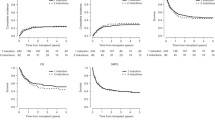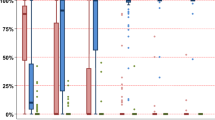Abstract
Double cord blood transplantation (DCBT) may overcome the slow hematopoietic recovery and engraftment failure associated with infusion of a single cord blood unit. In DCBT, only one unit typically contributes to long-term hematopoiesis, but little is known about factors affecting cord predominance. As results from a phase I trial suggested that order of infusion may affect cord predominance, we analyzed the effect of preinfusion variables on chimerism patterns of 38 patients enrolled in the initial study and a subsequent phase II trial. All patients were treated with a reduced-intensity conditioning (RIC) regimen of fludarabine, melphalan and thymoglobulin followed by DCBT. By day 100, 66% of patients had hematopoiesis derived from a single cord blood unit. Higher post-thaw total nucleated cell and CD34+ cell dose were associated with cord predominance and in 68% of patients (P=0.03); the predominant cord blood unit was infused first. Only the post-thaw CD34+ cell dose of the predominant unit predicted time to both neutrophil and platelet engraftment. Although based on a small number of patients, our results identify parameters that may affect cord predominance and engraftment in the setting of DCBT following RIC and suggest possible strategies for selecting infusion order for cord blood units.
This is a preview of subscription content, access via your institution
Access options
Subscribe to this journal
Receive 12 print issues and online access
$259.00 per year
only $21.58 per issue
Buy this article
- Purchase on Springer Link
- Instant access to full article PDF
Prices may be subject to local taxes which are calculated during checkout


Similar content being viewed by others
References
Laughlin MJ, Eapen M, Rubinstein P, Wagner JE, Zhang MJ, Champlin RE et al. Outcomes after transplantation of cord blood or bone marrow from unrelated donors in adults with leukemia. N Engl J Med 2004; 351: 2265–2275.
Rocha V, Cornish J, Sievers EL, Filipovich A, Locatelli F, Peters C et al. Comparison of outcomes of unrelated bone marrow and umbilical cord blood transplants in children with acute leukemia. Blood 2001; 97: 2962–2971.
Rocha V, Labopin M, Sanz G, Arcese W, Schwerdtfeger R, Bosi A et al. Transplants of umbilical-cord blood or bone marrow from unrelated donors in adults with acute leukemia. N Engl J Med 2004; 351: 2276–2285.
Takahashi S, Iseki T, Ooi J, Tomonari A, Takasugi K, Shimohakamada Y et al. Single-institute comparative analysis of unrelated bone marrow transplantation and cord blood transplantation for adult patients with hematologic malignancies. Blood 2004; 104: 3813–3820.
Ballen KK . New trends in umbilical cord blood transplantation. Blood 2005; 105: 3786–3792.
Ballen KK, Spitzer TR, Yeap BY, McAfee S, Dey BR, Attar E et al. Double unrelated reduced-intensity umbilical cord blood transplantation in adults. Biol Blood Marrow Transplant 2007; 13: 82–89.
Barker JN, Weisdorf DJ, DeFor TE, Blazar BR, McGlave PB, Miller JS et al. Transplantation of 2 partially HLA-matched umbilical cord blood units to enhance engraftment in adults with hematologic malignancy. Blood 2005; 105: 1343–1347.
Verneris MR, Brunstein CG, DeFor TE, Barker JN, Weisdorf DJ, Blazar BR et al. Risk of relapse (REL) after umbilical cord blood transplantation (UCBT) in patients with acute leukemia: marked reduction in recipients of two units. Blood 2005; 106: 93a.
Yoo KH, Kang HJ, Lee SH, Jung HL, Sung KW, Koo GC . Double unit cord blood transplantation in children with acute leukemia. Blood 2005; 106: 578a.
Brunstein CG, Barker JN, Weisdorf DJ, DeFor TE, Miller JS, Blazar BR et al. Umbilical cord blood transplantation after nonmyeloablative conditioning: impact on transplantation outcomes in 110 adults with hematologic disease. Blood 2007; 110: 3064–3070.
Majhail NS, Brunstein CG, Wagner JE . Double umbilical cord blood transplantation. Curr Opin Immunol 2006; 18: 571–575.
Kang HJ, Kho SH, Jang MK, Lee SH, Shin HY, Ahn HS . Early engraftment kinetics of two units cord blood transplantation. Bone Marrow Transplant 2006; 38: 197–201.
Rubinstein P, Dobrila L, Rosenfield RE, Adamson JW, Migliaccio G, Migliaccio AR et al. Processing and cryopreservation of placental/umbilical cord blood for unrelated bone marrow reconstitution. Proc Natl Acad Sci USA 1995; 92: 10119–10122.
Cutler C, Antin JH . Sirolimus for GVHD prophylaxis in allogeneic stem cell transplantation. Bone Marrow Transplant 2004; 34: 471–476.
Gray R . A class of K-sample tests for comparing the cumulative incidence of a competing risk. Ann Stat 1988; 16: 1141–1154.
Calvi LM, Adams GB, Weibrecht KW, Weber JM, Olson DP, Knight MC et al. Osteoblastic cells regulate the haematopoietic stem cell niche. Nature 2003; 425: 841–846.
Nilsson SK, Johnston HM, Coverdale JA . Spatial localization of transplanted hemopoietic stem cells: inferences for the localization of stem cell niches. Blood 2001; 97: 2293–2299.
Schofield R . The relationship between the spleen colony-forming cell and the haemopoietic stem cell. Blood Cells 1978; 4: 7–25.
Zhang J, Niu C, Ye L, Huang H, He X, Tong WG et al. Identification of the haematopoietic stem cell niche and control of the niche size. Nature 2003; 425: 836–841.
Dao MA, Creer MH, Nolta JA, Verfaillie CM . Biology of umbilical cord blood progenitors in bone marrow niches. Blood 2007; 110: 74–81.
Wagner E, Duval M, Dalle JH, Morin H, Bizier S, Champagne J et al. Assessment of cord blood unit characteristics on the day of transplant: comparison with data issued by cord blood banks. Transfusion 2006; 46: 1190–1198.
Ting DT, Ballen KK, Spitzer TR, Haspel RL, Dorn M, Pfeffer F et al. Effects of cord blood cell subset populations on the development of the dominant cord blood unit following non-myeloablative sequential double cord blood transplantation (DCBT). Blood 2007; 108: 898a.
Acknowledgements
This study was supported in part by the National Heart, Lung and Blood Institute (P01 HL070149).
Author information
Authors and Affiliations
Corresponding author
Rights and permissions
About this article
Cite this article
Haspel, R., Kao, G., Yeap, B. et al. Preinfusion variables predict the predominant unit in the setting of reduced-intensity double cord blood transplantation. Bone Marrow Transplant 41, 523–529 (2008). https://doi.org/10.1038/sj.bmt.1705933
Received:
Revised:
Accepted:
Published:
Issue Date:
DOI: https://doi.org/10.1038/sj.bmt.1705933
Keywords
This article is cited by
-
Advances in umbilical cord blood manipulation—from niche to bedside
Nature Reviews Clinical Oncology (2015)
-
The effect of equine antithymocyte globulin on the outcomes of reduced intensity conditioning for AML
Bone Marrow Transplantation (2014)
-
The evolving art of hematopoietic stem cell transplantation: translational research in post-transplant immune reconstitution and immunosuppression
Immunologic Research (2013)
-
Factors predicting single-unit predominance after double umbilical cord blood transplantation
Bone Marrow Transplantation (2012)
-
Quantitative monitoring of multi-donor chimerism: a systematic, validated framework for routine analysis
Bone Marrow Transplantation (2010)



